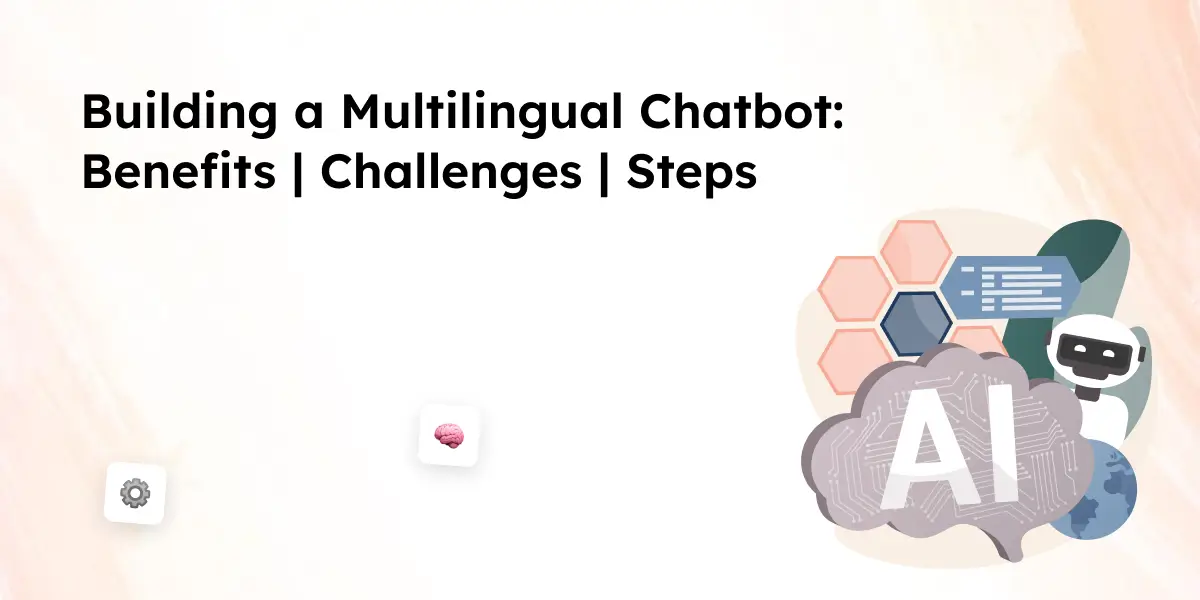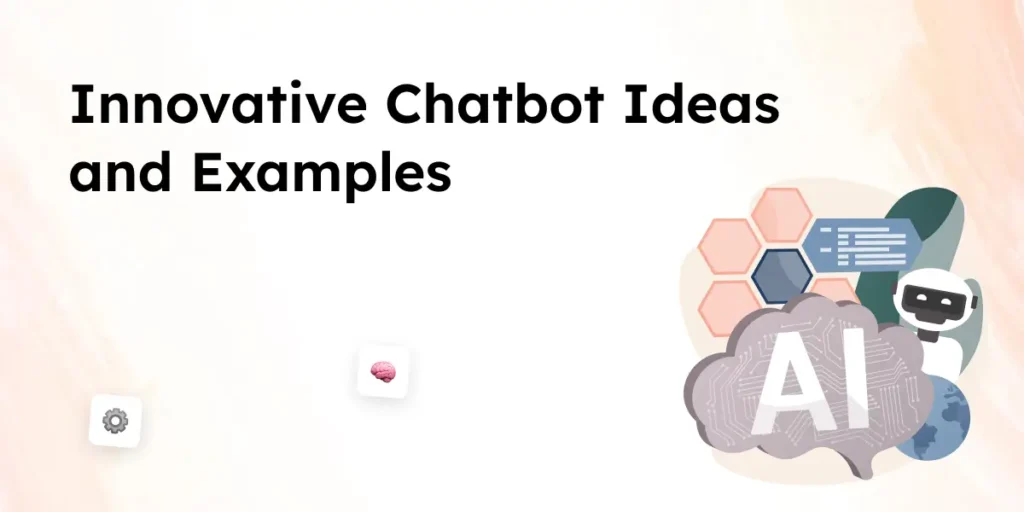Businesses need multilingual chatbots to provide seamless customer support in multiple languages. These AI-powered bots help break language barriers, improve engagement, and reduce reliance on human agents. As customer expectations for personalized interactions grow, chatbots enhance customer experience by detecting and responding in the preferred language.
Traditional support models are costly and inefficient, but chatbots powered by large language models and machine learning can handle thousands of queries instantly. They integrate with live chat, automate responses, and ensure smooth transitions to human agents when needed.
Companies benefit from cost savings, improved response times, and better customer satisfaction. Multilingual chatbots are essential for global businesses, allowing them to reach a wider audience while maintaining efficient communication.
Essential Features of a Multilingual Chatbot
A multilingual chatbot is more than a simple translation tool. It adapts to user preferences, understands context, and delivers natural responses. With AI advancements, chatbots now offer multilingual capabilities that make customer interactions smooth and efficient. Businesses can use chatbots to provide instant support in multiple languages while ensuring accuracy and relevance.
How AI and Large Language Models Improve Chatbots
AI chatbots rely on large language models and machine learning to enhance conversational fluency. These technologies help chatbots process customer queries, recognize intent, and provide contextually relevant responses in different languages.
- AI chatbots analyze customer input to understand queries beyond simple keywords.
- Large language models enable chatbots to provide human-like responses.
- Machine learning helps chatbots learn from interactions and improve over time.
- Natural language processing allows chatbots to detect customer intent in various languages.
- Sentiment analysis helps chatbots adjust their tone based on user emotions.
Building a multilingual chatbot requires global chatbot deployment techniques. Learn more in our best practices article.
Seamless Integration With Live Chat and Support Systems
For businesses using live chat or helpdesk platforms, integrating a multilingual chatbot enhances customer service without disrupting workflows. These chatbots can handle routine inquiries, provide automated responses, and escalate complex issues to human agents while maintaining conversation flow in the customer’s preferred language.
- Chatbots detect a user’s language preference and respond accordingly.
- They work alongside human agents, ensuring seamless transitions when needed.
- Integration with a knowledge base allows chatbots to provide instant multilingual support.
- Businesses can offer customer service in multiple languages without hiring additional staff.
- AI-powered automation reduces response times and improves overall customer satisfaction.
A well-developed multilingual chatbot helps businesses scale their support operations while maintaining a consistent customer experience across different regions. With the ability to respond in multiple languages and adapt to user needs, chatbots are transforming customer interactions worldwide.
Step-by-Step Guide to Build a Multilingual Chatbot
Building a multilingual chatbot requires careful planning and the right technology to ensure accurate responses across different languages. Businesses looking to enhance customer service with AI-powered chatbots can follow these steps to create a chatbot that provides multilingual support seamlessly.
Step 1: Define the Purpose and Select Target Languages
Before developing a chatbot, businesses must define its purpose and identify the languages it should support. Understanding the target audience helps in designing a chatbot that meets customer expectations.
- Determine if the chatbot will handle customer queries, automate FAQs, or assist with live chat.
- Research customer demographics to identify the most commonly spoken languages.
- Prioritize languages based on market research and customer engagement data.
- Ensure the chatbot can switch between several languages for a seamless experience.
- Consider regional language variations and cultural differences when designing responses.
Step 2: Choose the Right AI Platform for Multilingual Chatbots
Selecting an AI chatbot platform that supports multilingual capabilities is essential. Several AI-powered chatbot platforms offer built-in translation and natural language processing features to provide accurate responses.
- Choose a chatbot platform that supports multiple languages without any coding.
- Look for platforms that use large language models for better conversational intelligence.
- Ensure the chatbot can integrate with live chat, CRM, and customer support tools.
- Opt for AI solutions with sentiment analysis to adjust responses based on customer emotions.
- Consider platforms that offer a free trial to test multilingual capabilities before deployment.
Step 3: Train the AI Chatbot With Large Language Models
Once the chatbot platform is selected, businesses need to train the chatbot to understand and respond in different languages. AI and machine learning models help improve chatbot responses over time.
- Use AI-powered chatbots to provide personalized experiences in the customer’s preferred language.
- Implement natural language processing to enhance chatbot fluency.
- Train the chatbot with a knowledge base in multiple languages.
- Utilize AI models capable of understanding complex sentence structures.
- Ensure the chatbot’s responses are accurate and contextually relevant.
Step 4: Implement Machine Translation and Language Detection
A multilingual chatbot must detect the user’s language and respond accordingly. Combining AI-powered translation tools with language detection improves accuracy and ensures a seamless user experience.
- Use language detection to identify a customer’s preferred language automatically.
- Implement AI-powered translation tools for real-time multilingual support.
- Customize chatbot flows to provide a smooth transition between different languages.
- Ensure chatbot responses remain consistent across all supported languages.
- Test chatbot translations with real users to refine accuracy.
Step 5: Test, Optimize, and Deploy the Chatbot
Before launching a multilingual chatbot, businesses should test its functionality and optimize performance based on user feedback. Continuous monitoring helps improve chatbot accuracy and efficiency.
- Conduct live tests to ensure the chatbot understands customer queries correctly.
- Optimize responses based on real user interactions.
- Deploy the chatbot with multilingual capabilities across websites and messaging platforms.
- Gather customer feedback to refine chatbot responses and improve natural language understanding.
- Regularly update the chatbot to expand its language options and enhance customer experience.
By following these steps, businesses can create a multilingual chatbot that improves customer support, reduces response times, and provides a seamless conversational experience in multiple languages.
Benefits of Using a Multilingual Chatbot for Customer Service
A multilingual chatbot helps businesses improve customer service by handling queries in different languages without requiring a large multilingual support team. This AI-powered approach saves time and resources while ensuring customers receive timely and relevant responses.
Expanded Market Reach and Global Accessibility
Businesses that use a multilingual chatbot can expand their customer base by reaching audiences in different regions. Providing multilingual support allows companies to engage with customers in their native language, improving communication and trust.
- Chatbots allow businesses to break down language barriers and provide seamless customer support.
- Responding in multiple languages helps businesses connect with a truly global audience.
- Customers like chatbots that speak their language, improving customer satisfaction.
- A chatbot supports several languages without additional hiring costs.
- AI chatbots ensure consistency in messaging across different regions.
Faster and More Seamless Customer Interactions
A chatbot using AI-powered automation responds instantly, reducing wait times for customer queries. Unlike human agents, chatbots can handle multiple conversations at once, ensuring that no customer query is left unanswered.
- AI chatbots provide different languages for instant customer support.
- Language detection allows chatbots to switch to the customer’s language automatically.
- AI capabilities enable chatbots to understand customer sentiment and adjust responses accordingly.
- Integrating chatbots with live chat provides a smooth transition between AI and human agents.
- Customer queries are resolved by chatbots faster, improving response times.
Cost Savings for Businesses and Support Teams
Hiring a multilingual support team is expensive, but a multilingual chatbot allows businesses to offer 24/7 customer support in multiple languages without increasing staffing costs.
- Businesses can deploy chatbots to provide cost-effective customer support.
- AI-powered solutions reduce the burden on human agents, allowing them to focus on complex issues.
- Machine learning models enable chatbots to improve over time, making them more efficient.
- A chatbot platform helps businesses provide multilingual communication without additional expenses.
- Free trial options allow companies to test chatbot performance before committing to full deployment.
A multilingual chatbot not only enhances customer experience but also improves operational efficiency. By leveraging AI and natural language processing, businesses can offer personalized and reliable customer support in multiple languages, ensuring higher engagement and satisfaction.
Challenges When You Create a Multilingual Chatbot and How to Overcome Them
While a multilingual chatbot offers many benefits, businesses may face challenges in ensuring accuracy, maintaining conversational quality, and handling multiple languages effectively. Understanding these obstacles and finding AI-powered solutions can help businesses provide seamless customer interactions.
Handling Language-Specific Context and Cultural Sensitivity
A chatbot must do more than translate words—it needs to understand context, idioms, and cultural differences. Direct translations often lead to awkward phrasing or miscommunication, which can negatively impact the customer experience.
- AI chatbots must be trained to recognize regional language differences.
- Conversational AI solutions should consider cultural nuances when responding.
- Machine learning models help chatbots refine their responses based on user interactions.
- Businesses should use a multilingual chatbot that adapts to different languages naturally.
- Sentiment analysis helps chatbots adjust tone based on customer emotions.
Maintaining Accuracy in AI-Generated Translations
Even the most advanced AI solutions can struggle with translation accuracy. Businesses must ensure that their multilingual chatbot provides reliable responses in the customer’s preferred language.
- Language detection must be precise to avoid responding in the wrong language.
- AI capabilities should include feedback loops to improve chatbot accuracy.
- Natural language processing allows chatbots to understand and respond to complex queries.
- Businesses should train chatbots to handle multiple languages without errors.
- Testing chatbot translations regularly ensures a high-quality customer experience.
Ensuring Smooth Integration With Existing Systems
A multilingual chatbot should integrate seamlessly with customer support tools, live chat systems, and CRMs. Poor integration can lead to delays, inconsistent responses, and inefficiencies.
- A chatbot platform must support integration with existing tools without any coding.
- AI-powered chatbots should allow businesses to provide different languages for customers.
- Businesses should test chatbot responses across multiple platforms before full deployment.
- Multilingual communication must be consistent across all customer touchpoints.
- A chatbot should transition seamlessly between AI agents and human support teams.
By addressing these challenges, businesses can create a multilingual chatbot that delivers accurate, culturally appropriate, and efficient customer support. Proper AI model training, sentiment analysis, and language detection ensure the chatbot enhances customer interactions without compromising quality.
Future of AI Chatbots and Multilingual Capabilities in 2025 and Beyond
The evolution of AI chatbots is reshaping customer service, making interactions more intuitive and accessible. As businesses continue to expand globally, multilingual capabilities are becoming essential for delivering personalized customer support. AI-powered advancements will make chatbots even smarter, improving their ability to engage with customers in multiple languages while maintaining natural and context-aware conversations.
Advancements in Large Language Models for Chatbots
AI chatbots are expected to become more sophisticated as large language models continue to evolve. These models will enhance a chatbot’s ability to understand complex queries, detect intent, and provide accurate responses.
- AI chatbots will improve their ability to understand multiple languages naturally.
- Machine learning models will help chatbots refine responses based on real-time interactions.
- Conversational intelligence will enhance how chatbots respond to nuanced customer queries.
- Businesses will use AI-powered tools to automate multilingual communication effectively.
- Natural language processing will continue to advance, making chatbots more human-like.
Greater Integration With AI Agents and Business Systems
As AI becomes more powerful, chatbots will work alongside AI agents and live support teams to create a seamless customer service experience. Future chatbots will handle complex requests while ensuring smooth transitions to human representatives when needed.
- AI-powered chatbots will integrate better with customer support and CRM platforms.
- AI solutions will provide businesses with more control over chatbot responses.
- Multilingual chatbots will detect sentiment and adjust responses accordingly.
- Businesses will deploy AI chatbots across websites, apps, and messaging platforms.
- Language detection and personalization will make chatbots even more effective.
The Role of AI in Breaking Language Barriers
AI chatbots will play a significant role in breaking down language barriers, allowing businesses to connect with a global audience more effectively. With improved accuracy and real-time translation, chatbots will help companies reach a wider audience without the limitations of language.
- Businesses will use chatbots to provide customer service in several languages.
- AI chatbots will ensure seamless multilingual communication for international markets.
- Advanced AI models will allow chatbots to detect and respond in the customer’s preferred language.
- Sentiment analysis will enhance customer engagement by understanding emotions in different languages.
- AI applications will make multilingual chatbots more efficient in handling diverse customer needs.
With continuous improvements in AI capabilities, chatbots will become even more intelligent and adaptable. The future of multilingual chatbots looks promising, as they continue to enhance customer service, improve customer engagement, and provide a truly global support experience.
Conclusion
Businesses can enhance customer service and expand globally by using a multilingual chatbot. AI-powered chatbots automate responses, break language barriers, and improve customer engagement while reducing costs.
With advancements in large language models and natural language processing, chatbots now offer seamless multilingual communication. They integrate with live chat systems, detect language preferences, and provide personalized support.
Deploying a multilingual chatbot gives businesses a competitive edge by ensuring accurate, scalable, and instant customer service in multiple languages. As AI capabilities continue to evolve, now is the best time to implement chatbot solutions that improve efficiency and reach a wider audience.
FAQs About Multilingual Chatbots
1. What is a multilingual chatbot?
A multilingual chatbot is an AI-powered tool that can interact with users in multiple languages. It detects a customer’s preferred language and provides responses accordingly, ensuring a seamless conversational experience.
2. How does a multilingual chatbot detect a user’s language?
Most chatbots use language detection based on browser language settings, customer input, or account preferences. Some also allow users to select their preferred language manually.
3. Can a multilingual chatbot handle multiple languages at the same time?
Yes, modern AI chatbots can switch between different languages within a single conversation. They rely on natural language processing and machine learning models to ensure accurate translations and context-aware responses.
4. What are the benefits of using a multilingual chatbot for customer service?
A multilingual chatbot helps businesses expand their reach, reduce response times, and improve customer satisfaction. It provides automated support in multiple languages without requiring a large multilingual support team.



